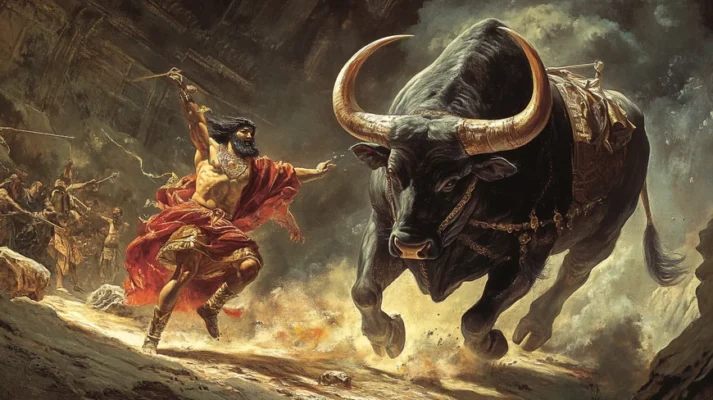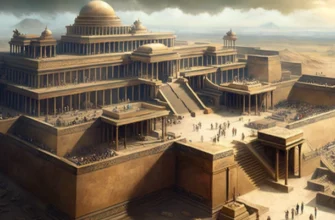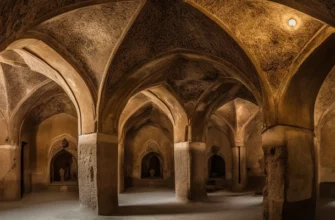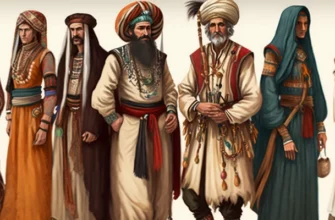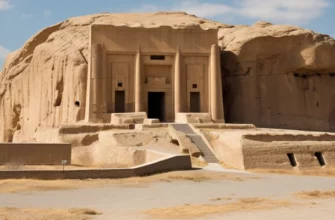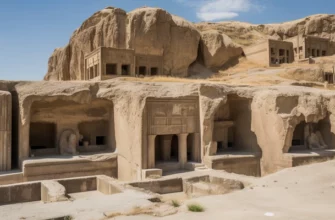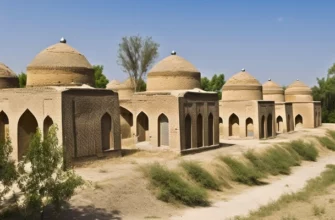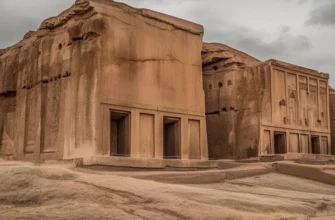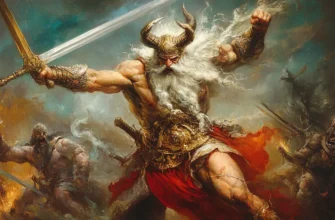The Iranian god Mithra, originating from ancient Iranian mythology, is one of the most significant figures in the religious and cultural context of Ancient Iran. Mithra was the embodiment of light and righteousness, and his cult had a profound influence on the development of religious ideas in the region.
Mithra’s origins can be traced back to Indo-Iranian roots, where he was originally the god of treaties and honor. In Iranian mythology, Mithra is often depicted as the faithful companion of the god Ahura Mazda, a fighter for order and justice. His cult was popular among Iranian tribes and spread through religious rituals and ceremonies.
Mithras was particularly important in Zoroastrianism, where his cult was an important aspect of religious practices. Mithras was considered the guardian of light and truth, and his rituals included prayers and sacrifices aimed at maintaining cosmic order.
Mithraism, which developed from the Iranian cult of Mithra, spread throughout the Roman Empire, where it became an important religious movement. Roman Mithraism retained many elements of the Iranian cult, but also adapted to new conditions, including new symbols and rituals.
In the modern world, the study of the god Mithra continues to attract the attention of scholars who study his influence on the development of religious and cultural traditions. Mithra remains an important subject of study for understanding the religious heritage of ancient Iran and its influence on subsequent religious systems. Origins and cults
Historical context
Mithra is one of the oldest and most important figures in the Iranian religious tradition, and his cult has Indo-Iranian origins dating back to before the emergence of Zoroastrianism. The earliest references to Mithra appear in the Avesta, the sacred texts of Zoroastrianism, where he is described as the god of light, covenants, and truth. Mithra was responsible for maintaining law and order, social justice, and protecting people from evil.
In Iran, Mithra was considered the guardian of world harmony (asha), and he acted as the protector of the world from chaos and darkness. His popularity began to grow in the 2nd millennium BC, when early Indo-Iranian tribes honored him through rituals and sacrifices.
The cult of Mithra remained influential even after Zoroastrianism was established as the state religion in the Achaemenid Empire (6th-4th centuries BC). However, its significance underwent a certain transformation: on the one hand, it retained its status as the faithful assistant of Ahura Mazda, the chief deity of Zoroastrianism; on the other hand, its cult was integrated into a new religious framework.
Mithra had a particular influence during the reign of the Parthians and Sassanids (3rd century BC – 7th century AD), when his image gradually became a symbol of world power and protection of royal authority. His worship during this period was marked by special rituals that emphasized his connection with military power.
A significant historical stage in the cult of Mithras began in the Roman Empire. From the end of the 1st century CE, Mithraism, which arose under the influence of Iranian religious ideas, spread among Roman soldiers and became a popular cult in the Western world. Mithraism in Rome had its own rituals and mythology, which, while retaining key Iranian elements, were adapted to new cultural conditions.
Thus, the historical context of the cult of Mithras encompasses several important stages: from early Indo-Iranian worship, through integration into Zoroastrianism, to its spread in the Roman Empire, where it developed into an independent religion.
Early forms of worship
Early forms of worship of the god Mithras date back to the Indo-Iranian religious tradition that emerged around the 2nd millennium BC. During this period, Mithras was worshipped as a deity of light, treaties, and justice. His image was closely associated with the sun and daylight, which opposed darkness and chaos. Mithra was considered the guardian of moral and social laws that governed the lives of both individuals and entire tribes.
In ancient Indo-Iranian cultures, Mithra was the chief deity who ensured that treaties and oaths were upheld. Any agreements between people or rulers were sanctified in the name of Mithra, as his role as the guarantor of justice made the violation of such agreements an extremely serious crime.
Rituals of worship of Mithra included sacrifices, prayers, and sacred rituals, often performed outdoors or in specially designated places. He was associated with the festival of Mitrachan, which symbolized the renewal of the solar cycle and was celebrated in the fall. During the rituals, animals were sacrificed to him, most often a bull, which personified strength and the rebirth of life.
Unlike later forms of Zoroastrianism, early worship of Mithra did not have a clear dualistic concept of the struggle between good and evil. He was the protector of harmony (asha) and truth, but did not yet act as a counterforce against purely evil demons. He was revered primarily as a god-mediator between heaven and earth, who ensures balance in nature and society.
In ancient Iran (especially among the Aryan tribes), the worship of Mithra was not only a religious practice but also a social norm that maintained ties between members of the community. It was important to keep oaths and agreements consecrated in the name of Mithra, as they were a guarantee of social stability.
Over time, when Zoroastrianism became the dominant religion in Iran, Mithra’s role changed slightly, but he continued to be revered as an important deity who personified light and justice.
Geographical spread of the cult
The cult of Mithra had a wide geographical spread, from its Indo-Iranian roots to its influence on other regions, especially in the Roman Empire.
Ancient Iran and India
The cult of Mithra originated within the Indo-Iranian community that existed in the territory of modern Iran, Afghanistan, Pakistan, and part of India. In its early stages of development, this cult shared common features with the ancient Indian worship of Mithra, who is also mentioned in the Vedic texts alongside Varuna. In India, Mithra was the god of light, harmony, and friendship, and his role was similar to that in the Iranian pantheon.
In ancient Iran, the cult of Mithra spread among the Aryan tribes, particularly the Medes and Persians, who made it an important part of their religion. When the Achaemenids (6th-4th centuries BC) became one of the most powerful empires in the world, the cult of Mithra strengthened its position in the region and even influenced state rituals. During this period, the worship of Mithra was associated with the worship of Ahura Mazda, the chief deity of Zoroastrianism.
Asia Minor and Greece
As a result of the Persian wars and the expansion of the Achaemenid Empire, the cult of Mithras penetrated Asia Minor, where it interacted with local religious traditions. In particular, in the Greek world, Mithras was sometimes identified with Helios, the god of the sun, reflecting his function as the deity of light and truth.
Roman Empire
One of the most important stages in the spread of the cult of Mithras was its penetration into the Roman Empire in the 1st century AD. Roman Mithraism probably came to Rome through Roman soldiers and merchants who served in the eastern provinces of the empire, particularly in Asia Minor. Over time, Mithraism became a popular religious movement among Roman soldiers, merchants, and officials.
The Roman cult of Mithras had its own characteristics, including ritual ceremonies in special underground temples called mithraea. It was secretive and closed to the general public, with clear initiation rituals that attracted soldiers and rulers. Mithraism spread most widely in the western provinces of Rome, including Britain, Germany, Gaul, and even North Africa. Archaeological finds confirm the existence of hundreds of mithraea in these regions.
Central Asia and Other Regions
In the territories east of Iran, including Sogdiana, Bactria, and parts of Central Asia, the cult of Mithras also maintained its presence, although it underwent some transformation due to local religious traditions such as Buddhism and local shamanistic cults. The influence of Mithras can be seen in the art and rituals of these regions, where he was associated with the sun and the protection of royal power.
Thus, the geographical spread of the cult of Mithras covered a vast territory, from India and Iran to the western borders of the Roman Empire. His worship, particularly in Rome, testifies to the uniqueness of this deity, who was able to integrate into different cultural and religious contexts, adapting his characteristics to new conditions.
Main aspects of the cult
The cult of Mithras was a complex and multifaceted religious system that included rituals, symbols, and beliefs that greatly influenced other religions. The main aspects of this cult can be divided into several key elements: rituals, symbols, social functions, and mythology.
Rituals and ceremonies
The cult of Mithras was characterized by secret ceremonies, which were accessible only to initiated members. The main rituals included sacrifices, most often of a bull, a symbol of rebirth and fertility. This sacrifice, known as tauroctony (bull killing), was central to the ritual and was considered an act of cosmic renewal.
Other rituals included prayers, animal sacrifices, and festive meals, where wine and bread symbolized the unity of the community. Of particular importance were the initiation rites that new followers of the cult underwent. There were several degrees of initiation, each symbolizing a person’s spiritual development.
Symbolism
Mithraism had a rich symbolism that was used in rituals and art. One of the key symbols was the image of Mithras killing a bull, a scene that was often depicted in mithraea (special underground shrines). This act had cosmic significance, symbolizing the rebirth of life through sacrifice.
Other symbols included the sun and moon, which were often depicted together with Mithras as the personification of light and darkness. Mithras was also associated with the sun god Sol Invictus, emphasizing his connection with the heavenly powers. In art, Mithras was depicted wearing a Phrygian cap, symbolizing his Eastern origins.
Social function
The cult of Mithras served an important social function, especially in societies where it was widespread. The most well-known aspect of his cult was its support of the military community. Mithraism became popular among Roman soldiers because the cult promoted the ideas of brotherhood, discipline, strength, and loyalty — values important to the army. The military chose Mithras as their patron because of his role as protector and guarantor of order.
Mithraism also supported the idea of social hierarchy through a system of initiation degrees, each with its own role and significance. This created a unique community within the larger Roman social structure, where each member had responsibilities and privileges depending on their degree in the religious hierarchy.
Mythological aspect
The mythology of Mithras was closely linked to ideas of a cosmic struggle between the forces of light and darkness. Mithras was considered a god who fought to maintain harmony in the universe. He symbolized light, truth, and order, while his opponents represented chaos and darkness. The main myth of the cult told of a cosmic battle in which Mithras defeats a bull, and new life springs from its blood.
Mithras also acted as a mediator between the gods and humans, and his cult included elements that emphasized his role in maintaining order in the world. He was often identified with the sun and had a close connection with seasonal cycles, which made him important to agrarian societies.
Cosmology and moral principles
The cult of Mithras was based on the concept of cosmic order (asha), where Mithras defended truth and justice. His main function was to ensure moral and social balance. Followers of Mithras believed that participating in his cult helped them achieve inner purification, spiritual growth, and personal harmony with the universe.
Thus, the main aspects of the cult of Mithras included deep symbolism, complex rituals, a strict moral system, and a mythological cosmology that linked him to the struggle for light and justice. The cult had a great influence on the religious and cultural consciousness of the ancient world, especially in Iran and the Roman Empire.
Mithra in Iranian mythology
Mithra is one of the central figures in Iranian mythology, revered as the god of light, truth, and treaties. His cult originates from the Indo-Iranian religious tradition, and his name can be found in both Iranian and Vedic texts of ancient India. Mithra played an important role in establishing cosmic order (asha) and ensuring justice among humans and gods.
In Iranian mythology, Mithra was part of a pantheon where he interacted with the chief god Ahura Mazda. He personified truth and order and was the protector of treaties and justice. His name, which translates as “friend” or “agreement,” emphasized his role as a mediator between the parties to a treaty. People considered Mithra a deity who monitored the observance of oaths and punished those who violated them.
In the Avesta, the sacred texts of Zoroastrianism, Mithra is mentioned as one of the great yazads (spirits) who help Ahura Mazda maintain order in the world. He was depicted as an almighty god who watches over the whole world and punishes liars and violators of agreements. His function is to maintain harmony between humans and gods, as well as to protect warriors and rulers.
Mithra was also a deity of light, symbolizing the struggle between good and evil in a cosmic sense. He personified the sunlight that dispels darkness and was an important deity in rituals associated with light and the sun.
Mithra interacted closely with the main deity of Zoroastrianism, Ahura Mazda. Although he was not the chief god himself, his role in maintaining world order was crucial. He was considered a mediator between heaven and earth, between gods and humans, helping to establish a connection between them through vows and covenants.
Mithra was also associated with the sun and moon, which emphasized his cosmic status. Although Sol Invictus (the unconquerable sun) later appeared as an independent god in the Roman Empire, in Iran, Mithra remained a symbol of sunlight and was a guide to truth and justice.
Symbolism and attributes
In Iranian mythology, Mithra symbolized light, truth, and justice. The god’s main attributes included the sun, which was a symbol of divine light, and a sword, which personified justice and punished oath breakers. In rituals and depictions, Mithras was often accompanied by the scene of the killing of a bull, which symbolized the victory of light over darkness and the rebirth of life through sacrifice.
The symbolism of the sun and its cycles were important aspects of the worship of Mithras, as his veneration was closely linked to agricultural cycles and seasonal changes. This cosmic symbolism emphasized his connection to the natural rhythms of life and death, as well as his role in maintaining harmony in the world.
Role in Zoroastrianism
In Zoroastrianism, Mithra was one of the main Yazats (spirits worshipped alongside Ahura Mazda). Although he was not the central deity in Zoroastrianism, his worship remained important. Mithra served as the protector of truth and justice, as well as the patron of treaties, warriors, and royal power. These aspects made him an important deity for rulers and the military.
During the Sassanid period (3rd-7th centuries CE), the cult of Mithra experienced a revival, although it was integrated into the Zoroastrian tradition. During this period, Mithra also became the patron of royal power, emphasizing his importance in the political sphere. He acted as a symbol of divine protection for kings, supporting their power and strength.
The influence of Mithra can be traced not only in Iran but also in other religious traditions. His cult spread throughout the Roman Empire, where it became an independent religion—Mithraism. This Roman version of the cult of Mithra shared common features with the Iranian god, particularly the symbolism of light and the struggle for truth, although it included new elements adapted to Western culture.
Thus, Mithra was an important religious figure in Iranian mythology, personifying light, truth, and order. His cult became the basis for religious and social ideas about justice, protection, and harmony in the world, and had an influence far beyond Iran.
The role and functions of the god in myths
Mithra played a central role in maintaining cosmic order and truth in Iranian mythology. His functions covered several key aspects, from preserving morality and justice to protecting society, warriors, and rulers. Here are the main roles and functions of Mithra in myths:
Defender of truth and treaties
Mithra was considered the chief deity who protected truth (asha) and ensured the observance of treaties and oaths. He had the function of guardian of agreements and justice both in relations between people and between people and gods. In the event of a breach of contract, Mithras acted as a judge and enforcer of just punishment. According to belief, he punished liars and those who betrayed their promises, ensuring moral order.
Deity of light
Mithra was closely associated with sunlight and the daily cycle. He personified the light that dispels darkness, symbolizing truth and enlightenment, opposing the forces of chaos and darkness. In myths, Mithra is often depicted as a deity who constantly watches over the world and monitors moral order thanks to his all-seeing eye, which never hides from the world.
Mediator between gods and humans
Mithra acted as a mediator, maintaining communication between humans and gods, as well as between rulers and the heavenly world. He not only ensured harmonious relations between these worlds, but was also the guarantor of promises and oaths made by both ordinary people and rulers. Mithra also played the role of protector of kings and state power, confirming the divine status of rulers and assisting them in the exercise of their power.
Patron of warriors and rulers
In the military sphere, Mithra was considered the patron of warriors, battles, and the protector of rulers. He was the god of war and victory, helping warriors defeat their enemies if they fought for truth and justice. Mithras supported valor and discipline, which made him an important figure among the military and kings. He was revered as a deity who brought victory and protected against evil.
Personification of moral law
Mithras personified moral law in the universe — he ensured that people acted in accordance with the principles of truth and justice. He was revered as a god who fought against evil, lies, and injustice, thereby maintaining harmony in the world.
Ritual functions
Mithra played an important role in rituals, especially those related to oaths, contracts, and sacrifices. His image and mythology were often used in ceremonies aimed at maintaining order in society and harmony in nature.
Thus, Mithra’s role in Iranian myths was multifaceted. He was the defender of truth, the patron of warriors and rulers, the deity of light and justice, and the mediator between heaven and earth. Mithra ensured moral and cosmic order, helping to maintain harmony in society and the world.
Interaction with other gods
Mithra, as one of the main deities of the Iranian pantheon, had a complex interaction with other gods, which emphasized his important role in maintaining cosmic order (asha) and justice. His relationship with other deities ranged from cooperation to complementarity in functions.
Ahura Mazda
Mithra’s main interaction was with the supreme god of Zoroastrianism, Ahura Mazda, the god of wisdom, truth, and light. Mithra, being a yazat (helper spirit), assisted Ahura Mazda in carrying out his will and protecting the righteous cosmic order. Mithra was often depicted as a divine judge who carried out Ahura Mazda’s instructions, especially in matters of preserving truth and punishing lies and breaches of contracts.
Ahura Mazda entrusted Mithra with overseeing justice among humans and gods. They worked together to maintain harmony in the universe, where Ahura Mazda created order and Mithra ensured its observance.
Angra Mainyu (Ahriman)
Mithra also opposed Angra Mainyu (Ahriman), the god of darkness, evil, and chaos, who was Ahura Mazda’s main adversary in the cosmic struggle between good and evil. Angra Mainyu personified lies, chaos, and destruction, which were the opposite of Mithra’s values — truth, order, and justice. As a defender of truth, Mithra was an active participant in the struggle against the evil forces led by Angra Mainyu. His task was to keep lies and chaos away from the human world and the world of the gods.
Sraosha (Srausha)
Sraosha, as the god of obedience and messenger of Ahura Mazda, often interacted with Mithra. Sraosha upheld the order and moral laws established by Ahura Mazda, similar to Mithra. He protected people from demons and was the patron of religious rituals, including prayers and offerings. Their joint activities emphasized the importance of maintaining moral and spiritual order, with Mithra responsible for protecting the truth and Sraosha for obedience and submission to divine laws.
Vayu (Vahu)
Vayu, the god of wind and air, also shared certain characteristics with Mithra. They both acted as patrons of warriors and were often associated with the elements that protect order. Vayu, as a two-faced god, was both peaceful and destructive, similar to Mithra, who also had the ability to punish and protect depending on the circumstances. Their interaction consisted of maintaining the natural and cosmic balance, ensuring the victory of good over evil.
Hvarhna (Far)
Hvarhna (Far), the deity of royal glory and luck, closely associated with royal power and world order, also interacted with Mithra. Mithra often acted as the protector of royal power, so Hvarhna, who symbolized the divine aspect of royal power, helped to strengthen this connection. The interaction between these two deities ensured that kings who ruled according to the principles of truth and justice would have divine support and blessings.
Anahita
Anahita, the goddess of water, fertility, and purity, was another important deity who interacted with Mithra. Her function was to support fertility and protect women and children. At the same time, Mithra, as the god of warriors and truth, was often associated with the protection of social and cosmic order. In myths, their cooperation was important for maintaining life and harmony in nature. Anahita was also the patroness of waters, which was important for the agricultural cycle, while Mithras ensured the correctness of this process through sacrifices and rituals.
Blending of functions with Sol (Sol Invictus)
In the Roman pantheon, Mithras merged with another solar deity, Sol Invictus (“Unconquered Sun”). This syncretic interaction became part of the cult of Mithraism in the Roman Empire. In both religions, the Sun played an important role as a source of light and heat, and Mithras and Sol Invictus shared similar functions. This syncretism contributed to the spread of the cult of Mithras beyond Iran and its integration into Western religious traditions.
Mithra interacted with various deities of the Iranian pantheon as the supreme protector of truth, mediator between gods and humans, and guarantor of cosmic order. He played an active role in the struggle against the forces of chaos (Angra Mainyu) and maintained order together with Ahura Mazda and other Yazats, such as Sraosha and Vayu. His connections with Hvarhna and Anahita emphasized the importance of Mithra’s role in ensuring royal power, fertility, and harmony in nature.
Symbolism and attributes
Mithra, as one of the main deities of the Iranian pantheon, had a rich set of symbols and attributes that emphasized his role in preserving truth, light, and cosmic order. The symbolism of Mithra is closely linked to his functions as the defender of truth, the sun deity, the patron of warriors, and the mediator between gods and humans.
Sun and light
One of the main symbols of Mithra is the Sun. He was often associated with sunlight, which symbolized truth, justice, and enlightenment. The sun, which rises every day, symbolized the victory of light over darkness, truth over falsehood. In some myths, Mithras was even depicted with the chariot of the Sun, emphasizing his connection with the daily cycle and the cosmic order.
The Sacred Bull
One of the most famous symbols of Mithras is the sacred bull. In mythology, the scene of Mithras killing the bull is a central image symbolizing the creation of new life through sacrifice. This act had cosmic significance, as the blood of the bull after the sacrifice gave birth to plants and animals, thus ensuring the fertility of the earth. The sacred bull personified the life force of nature, which Mithras controlled and renewed.
Dagger and sword
Mithras was often depicted with a dagger or sword, symbolizing his warrior nature and role as defender of truth. The sword and dagger were associated with his ability to fight against evil and injustice, as well as his participation in the cosmic battle between good and evil. These attributes also emphasized his role as the patron of warriors and defender of the state.
Phrygian cap
In many depictions, especially in the Roman cult of Mithraism, Mithras wears a Phrygian cap. This cap is a symbol of Mithras’ Eastern origins and his connection to Persian culture. The Phrygian cap also symbolized freedom and authority, as wearing it could indicate elevated status or power.
Cloak with stars
Mithras’ cloak, adorned with stars, symbolized his control over the cosmic order and his connection to the heavens. The stars on his cloak could indicate his ability to influence the course of the stars and planets, as well as his involvement in maintaining the cosmic balance between the forces of light and darkness.
Judgment and scales
As a defender of justice, Mithras was often associated with scales, a symbol of judgment and justice. The scales indicated his role in ensuring the balance between good and evil, as well as his function as a divine judge who punishes oath breakers and those who stray from the truth.
Snake
The snake is also an important symbol in the cult of Mithras, particularly in Roman Mithraism. In many depictions, the snake appears alongside Mithras during the scene of the sacrifice of the bull. The snake may have symbolized vitality and infinity, as in some cultures it was associated with rebirth and the cyclical nature of life.
Dog and raven
Along with Mithras, a dog and a raven were often depicted accompanying him in mythological scenes. The dog, drinking the blood of the sacred bull, symbolized loyalty and devotion. The raven could be Mithras’ messenger and was associated with his connection to the sun and the heavens. These animals emphasized different aspects of his nature: loyalty (the dog) and communication between the world of humans and gods (the raven).
Fire
Fire played an important role in the Zoroastrian religion, and Mithras was also associated with this element. Fire represented light, purification, and divine intervention. In some rituals in honor of Mithra, fire was used as a symbol of purification and justice, emphasizing his connection with sunlight and warmth.
Lion
The lion was another symbol that emphasized Mithra’s strength and power. In some depictions, Mithras is shown alongside a lion or in a scene where he is fighting a lion, which could symbolize the struggle against the forces of chaos or the defense of truth. The lion was also associated with sunlight and royal power, which reinforced his status as a deity who protects order.
Mithras’ symbols and attributes reflect his multifaceted nature as a god of truth, light, justice, and warriors. The sun, sword, bull, snake, scales, and Phrygian cap emphasize Mithras’ various functions, from guarantor of cosmic order to protector of human agreements. These symbols and attributes also contributed to the spread of his cult and its syncretism with other religions and cultures, particularly Roman Mithraism.
The Legacy of Mithras
The cult of Mithras has enormous historical and cultural significance, influencing the development of religious traditions and worldviews in various cultures. The legacy of Mithra is evident both in the Iranian context and in the Roman world through Mithraism, a religion that spread throughout Western Europe and became an important phenomenon during the Roman Empire.
Mithra in Zoroastrianism
In early Iranian beliefs, Mithra left a deep mark on the formation of religious ideology. As the protector of truth (asha) and cosmic order, he was one of the central figures in the Zoroastrian pantheon. Although his status later changed after the reforms of Zarathustra, some of his traits and influence remained. In Zoroastrianism, Mithra continued to play the role of judge and mediator between humans and gods, even when Ahura Mazda became the chief god. His functions as the protector of treaties and justice were preserved in the rituals and ethical principles of Zoroastrianism.
Roman Mithraism
One of the most important parts of Mithra’s legacy is his integration into Roman religion under the guise of Mithraism. Roman Mithraism, which flourished from the 1st century AD to the 4th century AD, was an esoteric religion focused on the worship of Mithra as the god of the sun, light, and protector of warriors. Mithraism was widespread among Roman soldiers, civil servants, and merchants, indicating its popularity in military and administrative circles. The cult of Mithras in Rome was secretive, with a complex initiation system and seven levels of initiation symbolizing the spiritual path to truth and light.
The main elements of Roman Mithraism:
The sacrifice of the bull: This symbol, known as tauroctony, was a central act in Mithraism and symbolized the renewal of life through sacrifice. Mithras killing the bull was an allegory of the victory of light over darkness and the creation of new life forces.
Ritual caves: Many Mithraic temples (mithraea) were built in the form of underground caves, symbolizing cosmic space and reminiscent of the birthplace of Mithras, who, according to myth, was born in a cave. These temples were places of rituals and community gatherings.
Solar symbolism: In Mithraism, Mithras was the god of the sun and light. His connection with the Roman god Sol Invictus (“Unconquered Sun”) played an important role, emphasizing his role as the protector of light and truth in the cosmic order.
Influence on Christianity
The legacy of Mithras, particularly his cult in Rome, partially influenced the development of early Christianity. Some researchers suggest that certain elements of Roman Mithraism may have been reflected in Christian rituals and symbolism. For example:
The celebration of Mithras’ birthday (December 25), which coincided with the winter solstice and the birth of the Sun, may have influenced the Christian celebration of Christmas.
The idea of a ritual supper and communal meal in Mithraism (ritual meal) may have a certain parallel with the Christian Eucharist.
The symbolism of the struggle between good and evil, light and darkness also echoes Christian ideology.
The legacy of Mithras influenced the development of religious thought and culture in many peoples, especially in the Middle East and Europe. In Iranian traditions, Mithras remained a symbol of moral strength that protects order and justice. His image became an example of the ideal warrior and defender, embodied in literature, art, and religious practices.
Mithraism also influenced Western occult and esoteric traditions, where it was seen as an example of mystical teaching. Many aspects of the cult of Mithras, such as the symbolism of the sun and secret rituals, became part of occult teachings in Europe during the Renaissance and later.
The image of Mithras has remained in modern culture as a symbol of the struggle of light against darkness, justice, and truth. His image is used in philosophical and spiritual studies related to ancient religions, as well as in popular culture, including literature, art, and cinema.
Mithras’ legacy is multifaceted and influential. His cult played an important role in shaping religious and cultural traditions in both the East and the West. Mithras remained a symbol of the struggle for truth, light, and justice, and his cult became an integral part of the religious heritage of both Zoroastrianism and the Roman world.
Conclusion
The study of the god Mithras is important for understanding the development of the religious, cultural, and social aspects of ancient civilizations. His cult, which originated in Iran and found its place in Rome, demonstrates the complex interaction between religious beliefs, social structures, and politics. Mithras embodies the multifaceted themes of justice, light, and the struggle between good and evil, which remain relevant in the modern world.
Studying Mithras provides a deeper understanding of how religious traditions are formed, adapted, and influence human life. This knowledge not only enriches our understanding of the past but also provides valuable lessons for the present, offering new perspectives on ethics, morality, and social relations. Mithras’ legacy lives on in culture, religion, and philosophy, underscoring his importance in human history.
Thus, the study of the god Mithras is significant not only for the history of religions but also for a wide range of academic disciplines, including anthropology, cultural studies, history, religious studies, and sociology. This research helps to deepen our understanding of how ancient beliefs influence contemporary cultures and values, and reveals enduring themes that shape the human experience across centuries.
